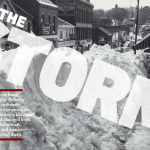When “Maudlin” Was “In”
Welcome to the November 2008 edition of “Jud’s New England Journal,” the rather curious monthly musings of Judson Hale, editor-in-chief of Yankee Magazine, published since 1935 in Dublin, New Hampshire. When “Maudlin” Was “In” Years ago in New England, people viewed death and dying quite differently …Get Our FREE Yankee Best New England Vacations Guide! […]
Welcome to the November 2008 edition of “Jud’s New England Journal,” the rather curious monthly musings of Judson Hale, editor-in-chief of Yankee Magazine, published since 1935 in Dublin, New Hampshire.
When “Maudlin” Was “In”
Years ago in New England, people viewed death and dying quite differently …
About a month ago, when I had a little spare time in Cambridge, Massachusetts, I decided to take a walk through Mount Auburn Cemetery, known as the “Gateway to Heaven.” With the fall foliage just coming along, it was beautiful in there, but I really marveled at the size and elaborateness of some of the larger mausoleums. The sculptures are quite something, too — including weeping maidens, life-size statues of dead children, tons of cherubs, urns, and weeping willows. I was reminded that it wasn’t so long ago that what is considered extravagantly maudlin today was once very much “in.”
My grandmother, for instance, displayed in her house a wreath made from the hair of a dead relative. I believe she told me it was her brother’s. On the mantelpiece in the same house was my grandfather’s appendix, pickled in a jar. Whenever we visited “Pop” and Grandma when I was a boy, that particular mantel was where I’d head first. And I’d stare, always fascinated.
Absent for the most part from Mount Auburn are the quirky-but-memorable epitaphs one sometimes finds in the older graveyards around New England: “I told you I was sick, Maude” and the like. Mount Auburn was, and still is, too proper for any but the most dignified memorials.
Dignity is an important requirement of almost any stone reminder of a onetime presence here on Earth. But the most dignified and elaborate of memorials aren’t always an indication of great wealth and New England social position. There have been many people who decided to save for years in order to have a really fancy remembrance.
For example, a man named Lucas Douglass died, apparently penniless and alone, on the streets of Ashford, Connecticut, one cold December night in 1895. He’d never married and had few relatives. Shortly after his death, it was discovered his will left enough money — thousands of dollars — to erect, as he stipulated, a 34-foot-high monument of Italian marble, complete with headstone, urns, and a 140-foot stone wall surrounding the plot. It’s there to be seen in Westford Hill Cemetery today. It includes epitaphs (“I have heard Thy call”), a portrait of Douglass in a circular medallion, and all manner of various inscriptions. Since he ordered all this before he died, at least he must have had some satisfaction in picturing it there for all to see forever. But the most common reaction of the several hundred tourists who view it each year is one of wonder and pity.
Henry Daniel Cogswell, a wealthy Rhode Island dentist of the 19th century, encountered far worse reactions to his efforts at self-perpetuation. In fact, his major contribution to the world may have been the regulations of today’s fine-arts commissions relative to the suitability and good taste of monuments in public places. Not that Dr. Cogswell initiated such rules. Rather, it was his memorials that demonstrated the need for them. It seems that the good doctor donated large stone monuments doubling as drinking fountains (he was a teetotaler) to Boston, Fall River, Pawtucket, and more than a dozen other American cities, each topped by a statue of himself and, unfortunately, as described in a New Haven newspaper of the day, “outlandishly ugly.”
One of the few remaining Cogswell fountains stands today in Central Park in Rockville, Connecticut. Years ago, it was thrown into a nearby lake, as many of Cogswell’s memorials were, but was retrieved in 1969 and erected in its present location, with a flowerpot substituting for the statue of Dr. Cogswell. There’s another at the entrance to Slater Park in Pawtucket, Rhode Island. You might want to go see it. As for me, I think I’d still rather stare at my grandfather’s appendix.







